Satisfy your inner cravings with these easy kimchi Korean rice balls (jumeok bap, 주먹밥). Simply made by blending leftover sushi rice with kimchi and vegetables, shaping them into a compact ball, and finally coating them with a homemade seaweed seasoning. Try stuffing the rice balls with leftover bibimbap or BBQ beef for a tasty lunch, snack, or party appetizer.
These kimchi rice balls might only be bite sized, but they deliver big bold umami flavors with their spicy, savory, and tangy notes. Delicious chilled or even at room temperature making them the star of any bento lunch box.
As a bonus, we are sharing with you how to make homemade furikake seasoning (rice sprinkles) because we are all about staying on budget and using up the ingredients you have on hand.
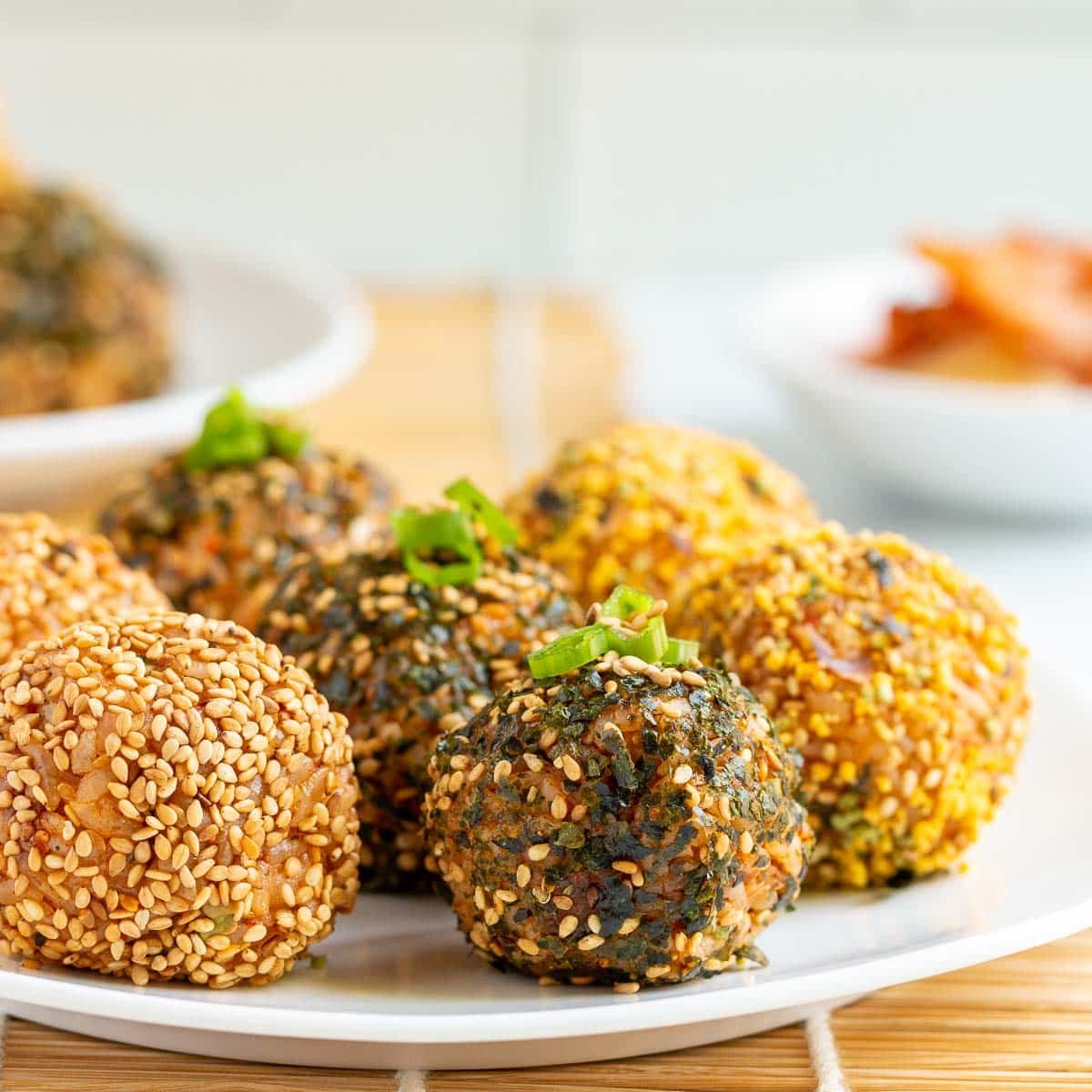
Jump to:
- Budget Friendly
- Ingredients Jumeok bap
- Nori Furikake
- How to Make Rice Balls?
- 3 Ingredient Home Furikake Rice Seasoning
- How to make Homemade Furikake Seasoning?
- How to Make Rice Balls Hold Together?
- Favorite Fillings
- How to Stuff?
- How to Serve?
- Frequent Asked Questions (FAQ’s)
- More Easy Bento Box Ideas
- More Delicious Korean Recipes
- Kimchi Korean Rice Balls
Budget Friendly
Are you still recovering from sticker shock from the last grocery trip? Let’s double down and make sure that no food goes to waste. You can literally add anything to sticky rice balls – making them the perfect vessel for refrigerator clean out day.
You would be amazed at all the delicious pantry meals you can make with the little bits and bobs of veggies or proteins in your refrigerator and a few staples. If grandma could make something delicious appear like magic, so can we!
Ingredients Jumeok bap
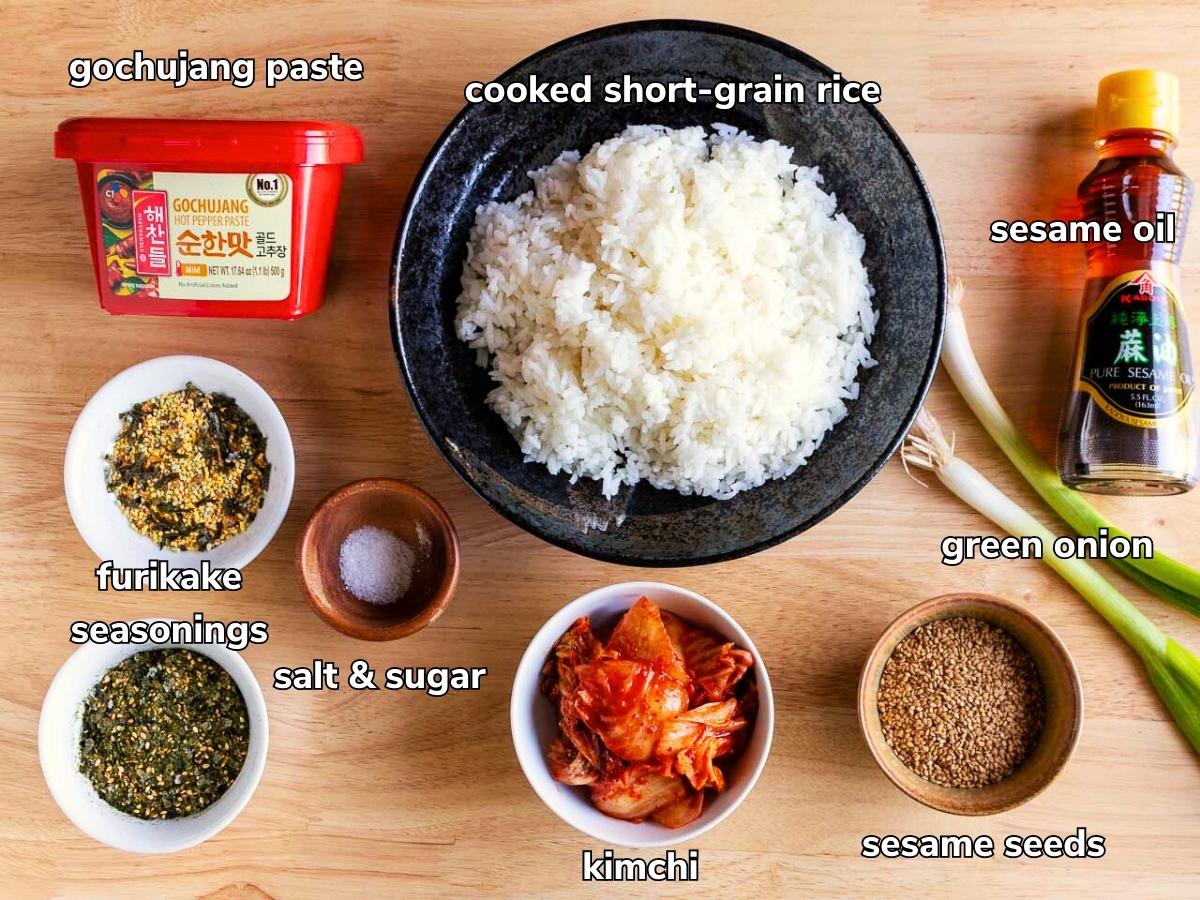
Cooked short grain rice (sushi rice) is called bap or 밥 in Korean. This grain has more starch, making it stickier than long grained rice and thus easier to form balls. Just because it is stickier, please do not confuse this with sweet glutinous type used to make mango sticky rice.
Toasted Sesame Oil is one of the most important ingredients. This simple ingredient is what differentiates Korean Rice Balls from Japanese Rice Balls. We also use sesame oil to prevent the rice from sticking to our hands when we are rolling them.
Kimchi – is made with salted fermented vegetables like napa cabbage and more. It gives these Korean snacks a delicious umami and funky flavor just like our creamy kimchi pasta. Not to mention, fermented foods are great for your gut biome and act like a probiotic.
Vegetables – We used some sliced green onions but grated carrot, finely sliced spinach, chopped bean sprouts and more are all delicious in rice balls. Bibimbap (Korean mixed rice bowl) leftovers are a nice addition too. The caveat is that all the vegetables or even mushrooms need to be finely chopped and cooked so that they are pliable and can easily be formed into a compact ball.
Proteins – now this is something you can have fun with. Try adding in or stuffing a little finely chopped Korean beef bulgogi, scrambled eggs, tuna fish or baked miso salmon into the center of the rice ball. It is all about cleaning out the little leftover bits and bobs in the refrigerator.
Gochujang – is a fermented Korean red chili paste. This optional ingredient gives our fried rice with leftover ham and kimchi Korean rice ball a kick of sweet and heat.
Nori Furikake
Dried Seaweed Seasoning is the Korean version of Japanese furikake. These fun “rice sprinkles” add flavor and texture to plain rice and kids LOVE it. In addition, it prevents these snacks from sticking to everything they touch. This seasoning usually includes dried roasted seaweed (also known as laver or Gim (김) in Korean) along with some other ingredients like dried vegetables, roasted sesame seeds, salt other flavorings.
You can purchase in the Asian food section of the grocery store or at an Asian food market. Today, we are going to show you how to make your own homemade rice sprinkles.
How to Make Rice Balls?
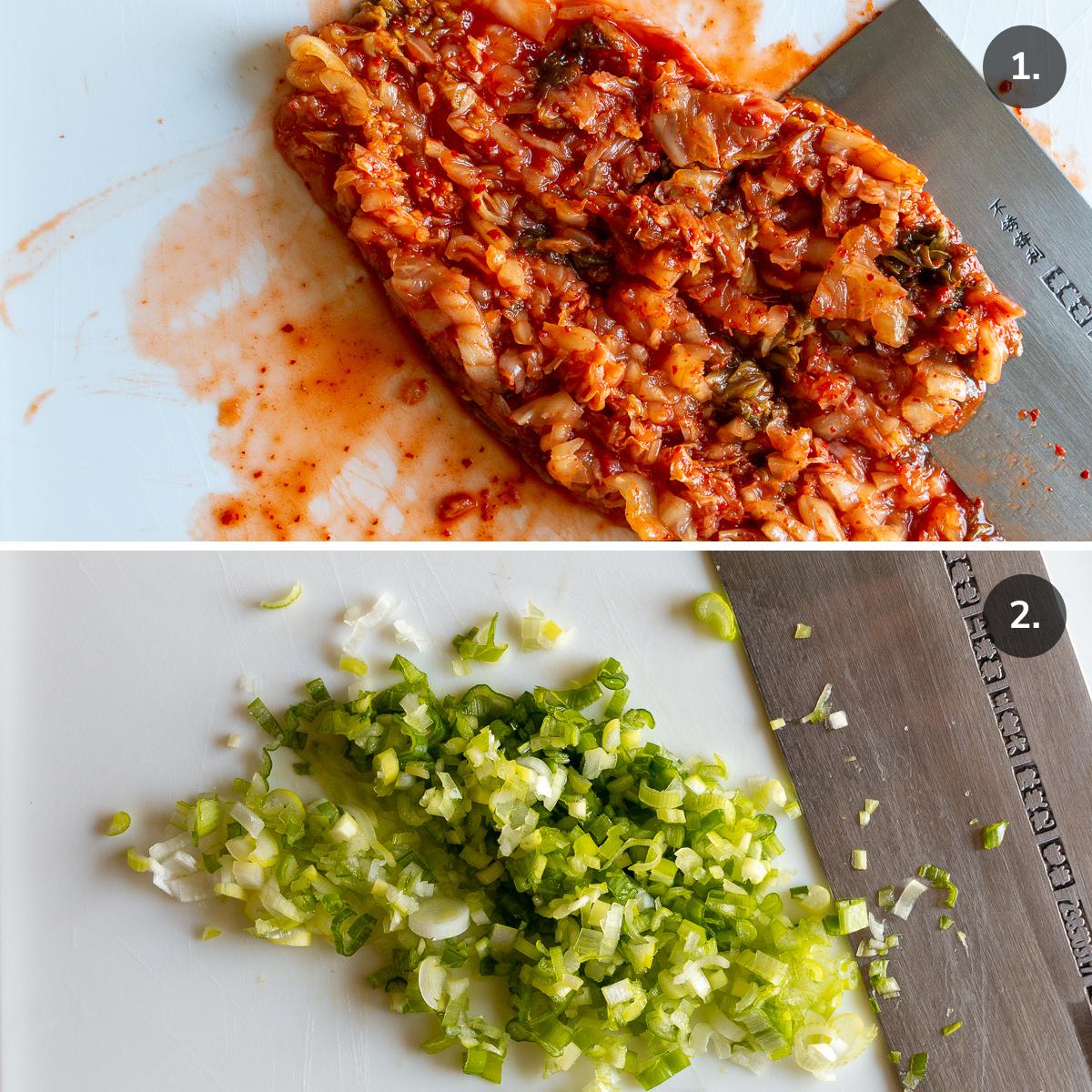
- Chop up kimchi, green onions and any vegetables or proteins desired.
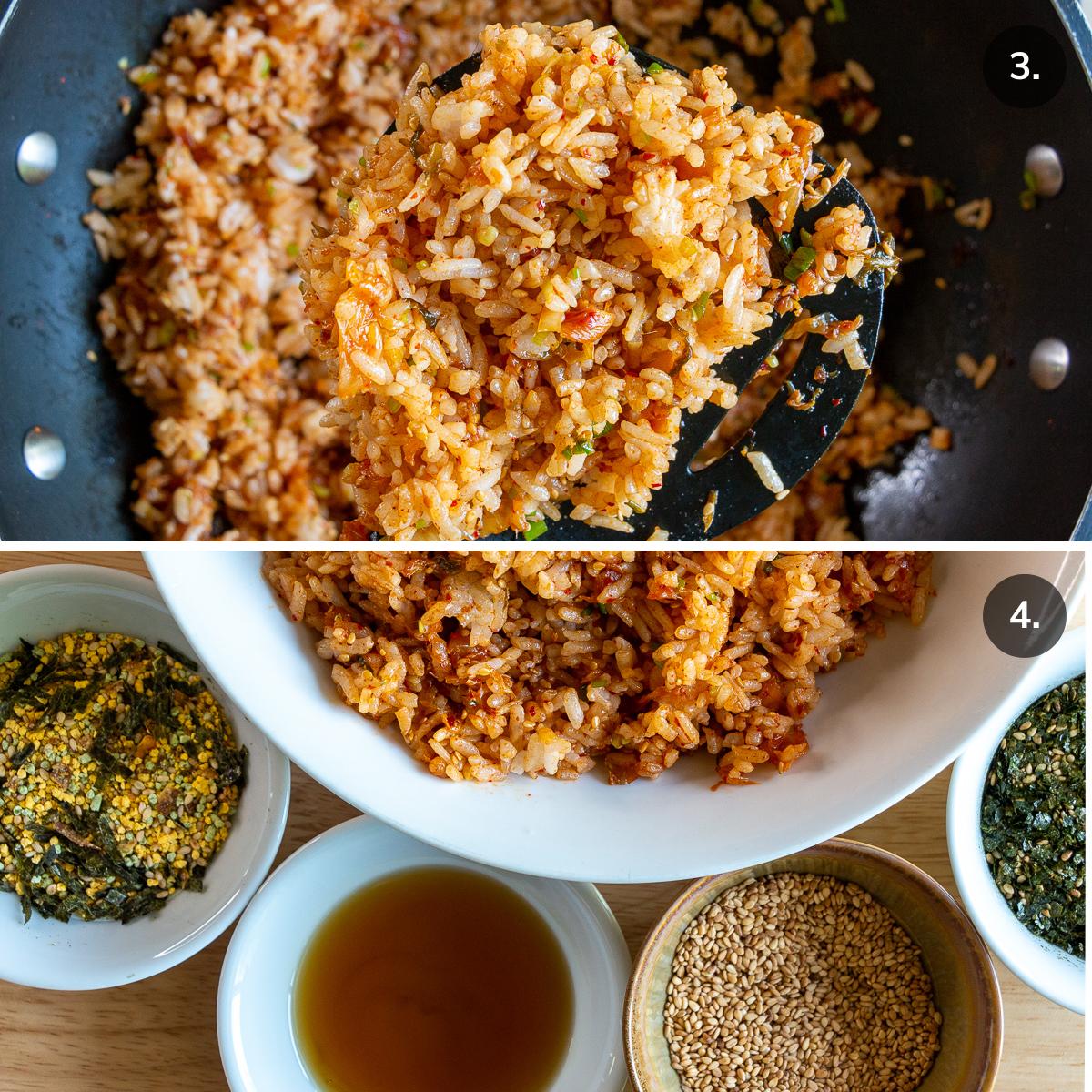
- Toss in kimchi and vegetables to a pan or wok and cook until aromatic and the liquids are absorbed.
- Add sesame oil gochujang, leftover short-grained rice, and sesame seeds to the kimchi in the pan and stir until well incorporated and the rice is warm.
- Sprinkle dried Korean Furikake seaweed seasonings on flat plates. Set aside extra sesame oil in a small bowl. Place the lightly warmed cooked kimchi rice near you so you can make Korean rice balls in assembly line fashion.
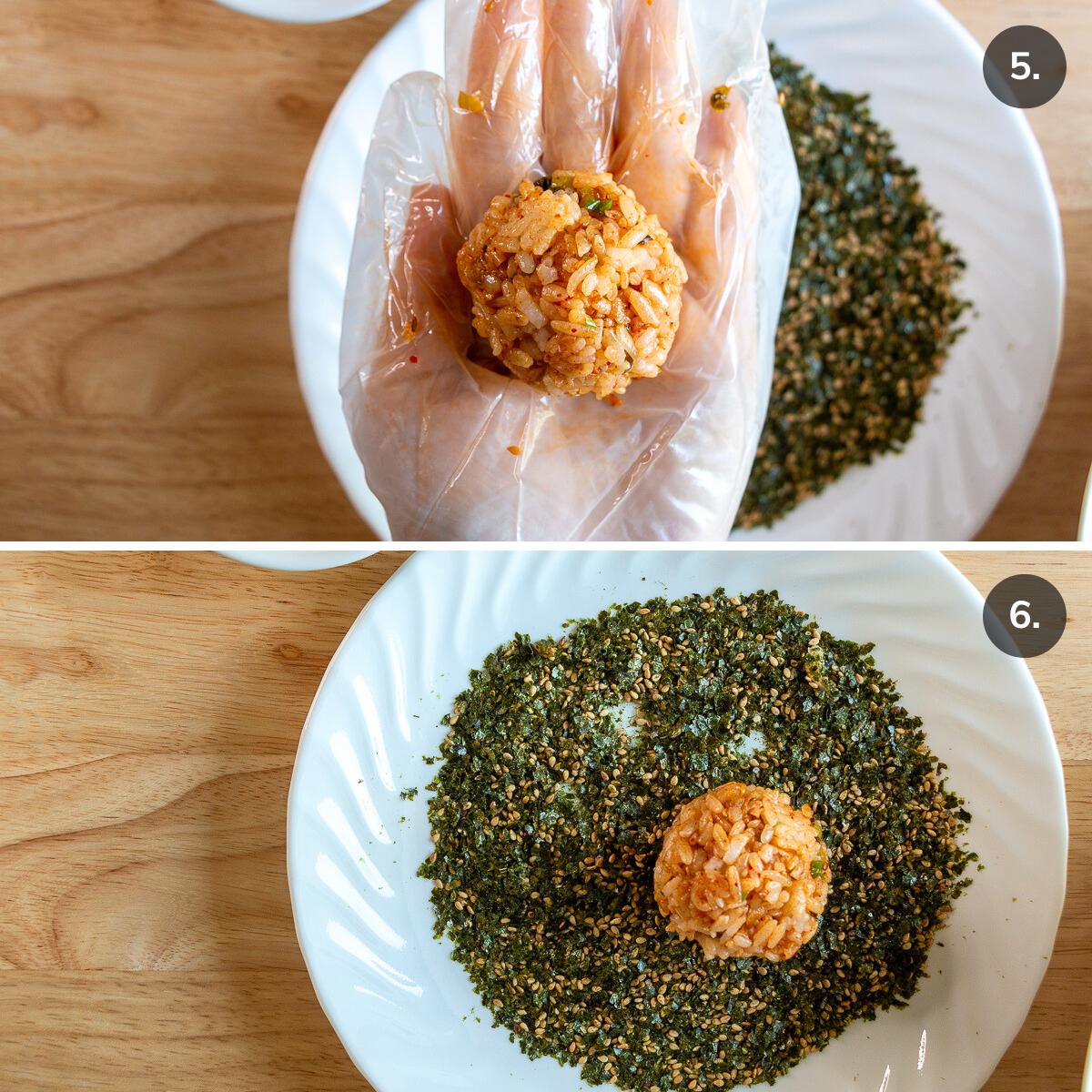
- Dip your fingers or disposable gloved fingers into the sesame oil and rub your hands together to lubricate and prevent sticking. Alternatively, you can dip your fingers and hands into water.
- Place approximately ¼ cup of rice in your hand and squeeze tight and form into a ball. You can also use a small sheet of plastic wrap to help form it into a tight ball.
- If you want to add a stuffing of bulgogi beef, bibimbap, tuna mayo or any other proteins or vegetables in the middle, first place about 2 tablespoon of warmed kimchi rice in your hand. Next, place a little spoonful of the stuffing and then another tablespoon or so of the kimchi rice on top. Then squeeze and form into a ball.
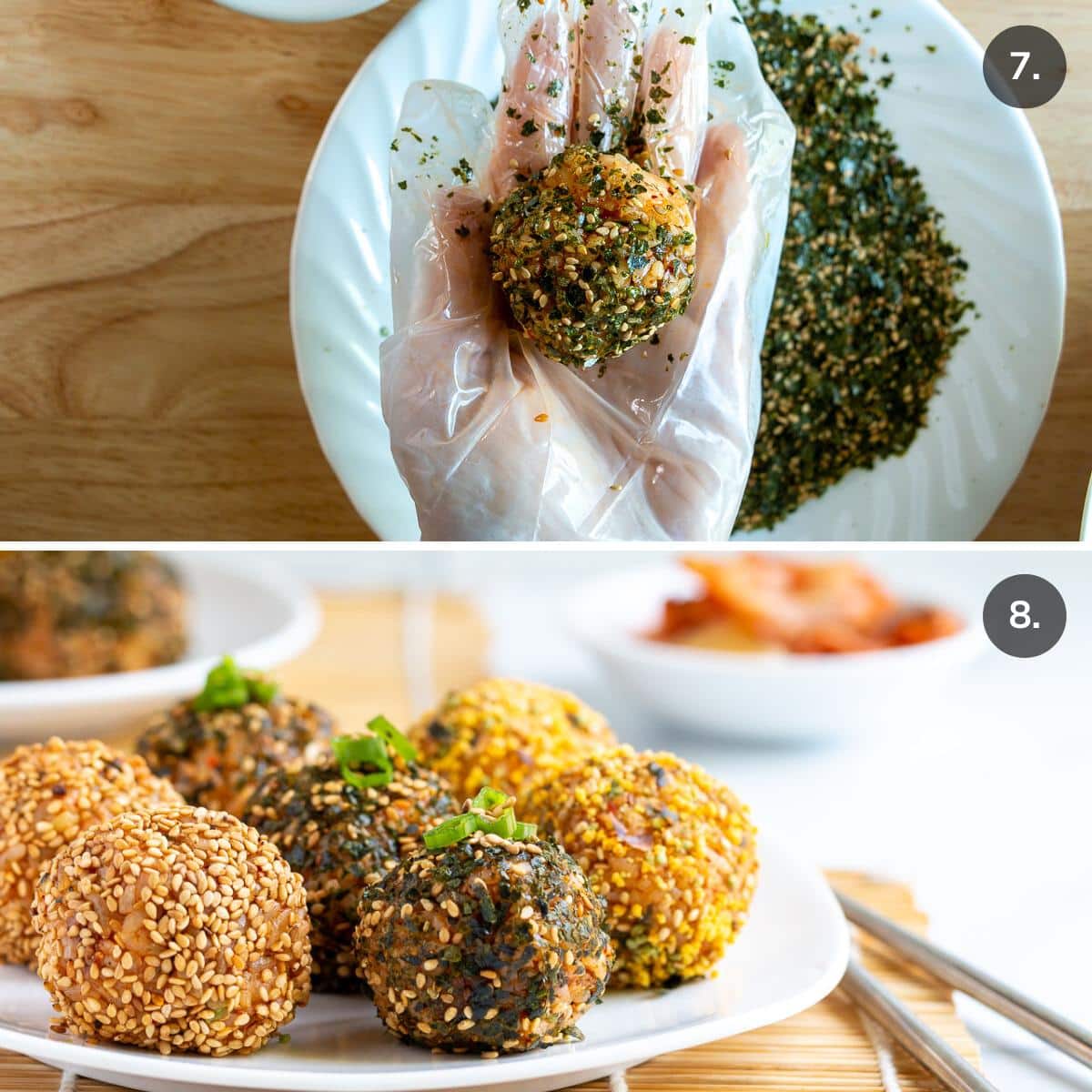
- Lastly, roll in the seaweed for rice balls or toasted sesame seeds.
- Enjoy!
3 Ingredient Home Furikake Rice Seasoning
Furikake is a dried rice seasoning. Our family refers to them as “rice sprinkles”. It turns bland boring white rice into a tasty bite. If you can’t find this Asian seasoning at the grocery store, you can use this easy furikake substitute recipe and personalize it to your taste preferences. It’s less expensive than store bought and fresher too!
- Roasted dried seaweed sheets – also known as nori, laver, gim, or김. These can be plain or seasoned.
- Salt
- Toasted sesame seeds – we used white sesame seeds, but you can also use black or a combination of both.
How to make Homemade Furikake Seasoning?
Our version of nori furikake is unique because we roast the seaweed sheets directly over the stove top burner to make them extra crunchy and it gives them this delicious toasty flavor. Head on over to our YouTube channel so you can see how we make this 3 ingredient furikake rice seasoning in action.
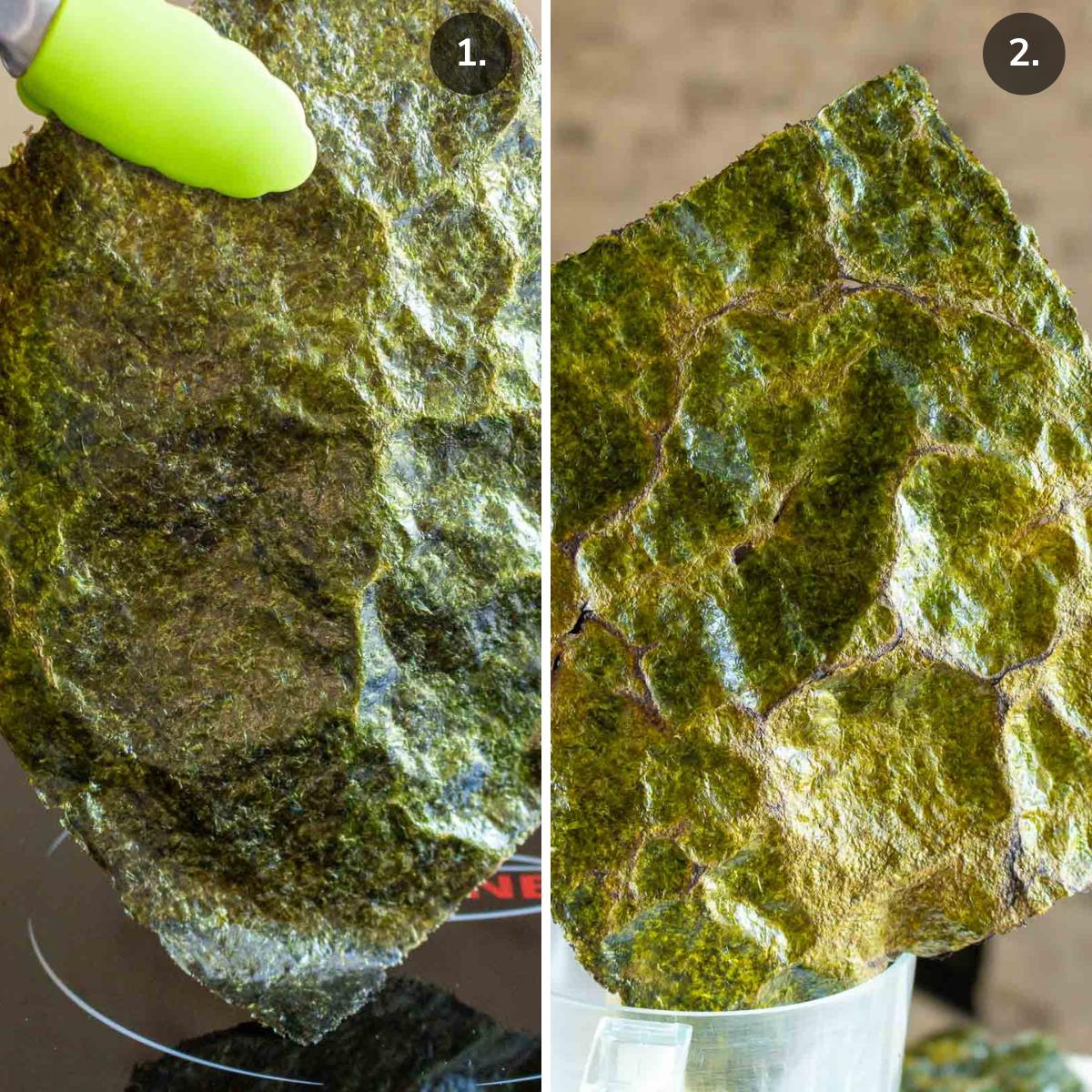
- Toast the dried roasted seaweed sheet directly over the stove top. Hold on to a corner of the seaweed sheet with a pair of tongs.
- Carefully, brush the sheet quickly back and forth on both sides over a low-medium heated stovetop. You can do this on a gas, electric or any type of stovetop.
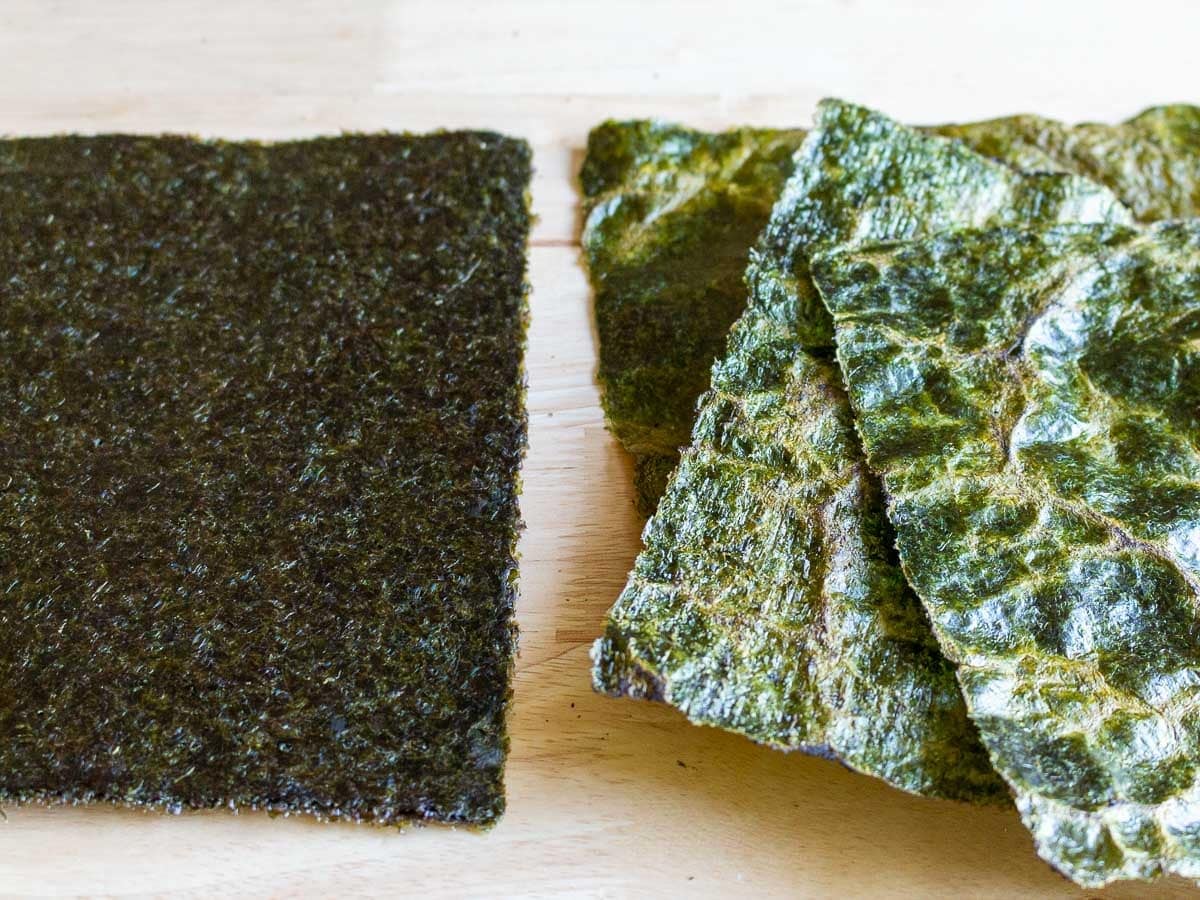
- Check out these visual ques in the photo above. Do you see how the seaweed (nori) sheets turned from a dark green to a bright Kelly-green color and have a tie-dyed look? Now, they are perfectly roasted.
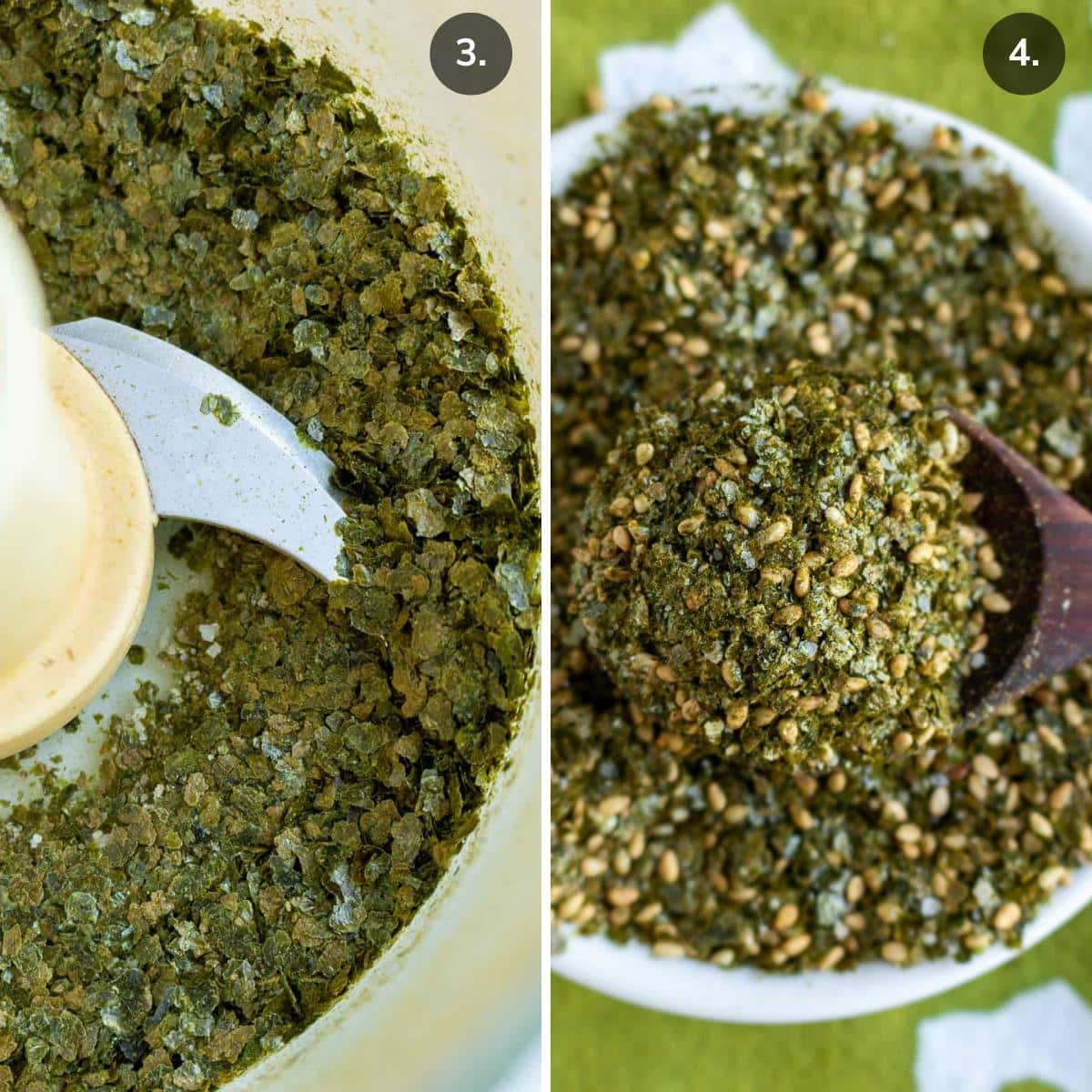
- Crumble the toasted seaweed sheets and place them in the food processor or high-powered blender. Add salt and any other seasoning you wish along with the crushed nori. Pulse into a sesame sized furikake seasonings.
- Next, add the toasted sesame seeds into the food processor. Pulse a couple of times just until the sesame seeds lightly break, and some are still whole.
- Have fun with additions. Try adding dried bonito flakes, chili flakes, wasabi powder, white pepper, sugar, dried shrimp, dried shiitake mushroom powder or any of your favorite dried seasonings.
- If you do not have roasted seaweed sheets, no worries. Instead, just add sesame seeds and salt together along with any other dried spices you like.
How to Make Rice Balls Hold Together?
Proper Ingredients
- Use short-grained sushi rice cooked per the package directions. Do not use long grained, brown, or black rice as these have different textures and are not sticky.
- To prevent the rice from sticking to your hands, dip your fingers into sesame oil or water and rub your hands together. Keeping your hands lubricated with water or oil will make it easier to roll.
- If you decide to add other veggies into the mixture, make sure that they are grated or chopped finely and cooked. In addition, the vegetables need to be cooked to remove any extra moisture. The ratio of cooked vegetables, including the kimchi to rice is 1 and ¼ cups vegetables to 3 cups cooked rice. If you add more, the balls may not hold together.
Technique
- Heat the rice before forming it into balls – just until warm so it is not too hot to handle. If you are using leftover rice, you can warm it in the pan or microwave with the rest of your ingredients. Cold rice does not stick together as well as warm rice.
- Don’t make the rice balls too large! The larger the ball, the more difficult it is to make them stick together. This easy recipe makes approximately eight 2 inch sized Korean treats. Using approximately ¼ cup of the kimchi rice mixture for each ball is just about right.
- After you grab a scoop of rice, squeeze it with both of your hands tightly. Using this firm pressure will help the balls stay in shape. Once you do this a few times, shape them into a round compact ball. Check out the video below as we demonstrate how to do this.
- Use a piece of plastic wrap around the balls and tie it tightly. If you have a hard time making a round shape or getting your balls to hold together, this technique is useful.
- Lastly, refrigerate these kimchi treats for 30 minutes before serving. This helps them hold their shape.
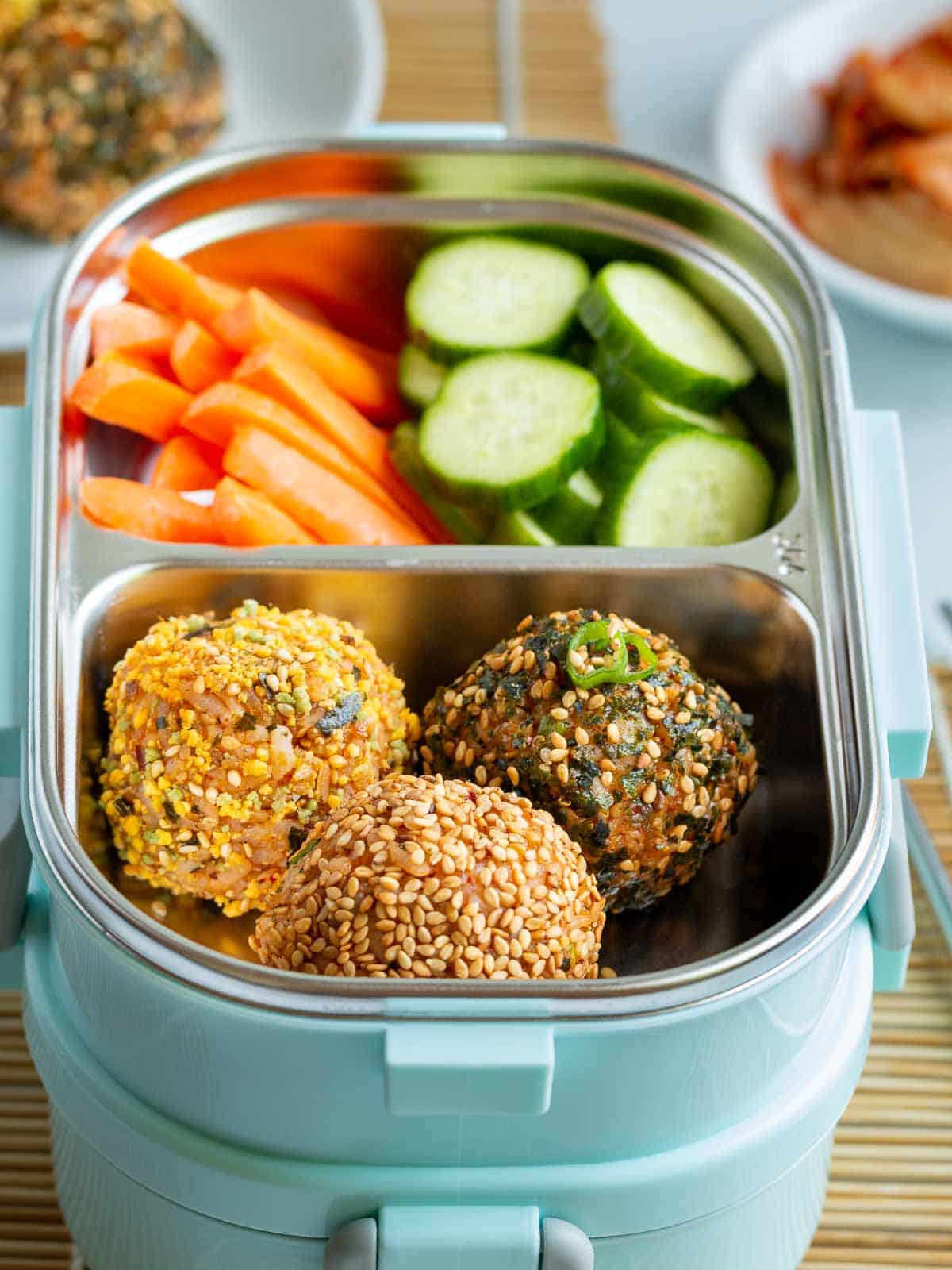
Favorite Fillings
Get creative and add fillings to your Korean rice ball recipe. The only caveat is they need to be finely chopped, seasoned, and stir fried to remove any extra moisture. Some of our favorite fillings are…
- Bibimbap or bulgogi beef
- Tuna mayo – this does not need to be stir fried.
- Sauteed minced shiitake mushrooms
- Stir fried vegetables.
How to Stuff?
Amp up the flavor with your favorite Asian fillings. This step is not required. However, it is a great way to use up all those bits and bobs of leftovers in your refrigerator. In addition, it’s a more substantial lunchtime option.
- It’s the same prep procedure as before. Lubricate your hands with sesame oil or water.
- Place about 2 tablespoons of the kimchi rice in your hand and flatten it out.
- Then, add about 1 teaspoon of your filling of choice.
- Place another 2 tablespoons of kimchi rice on top of the filling.
- Squeeze the rice and filling mixture together and form into a ball.
- Roll into the Korean Furikake rice seasoning.
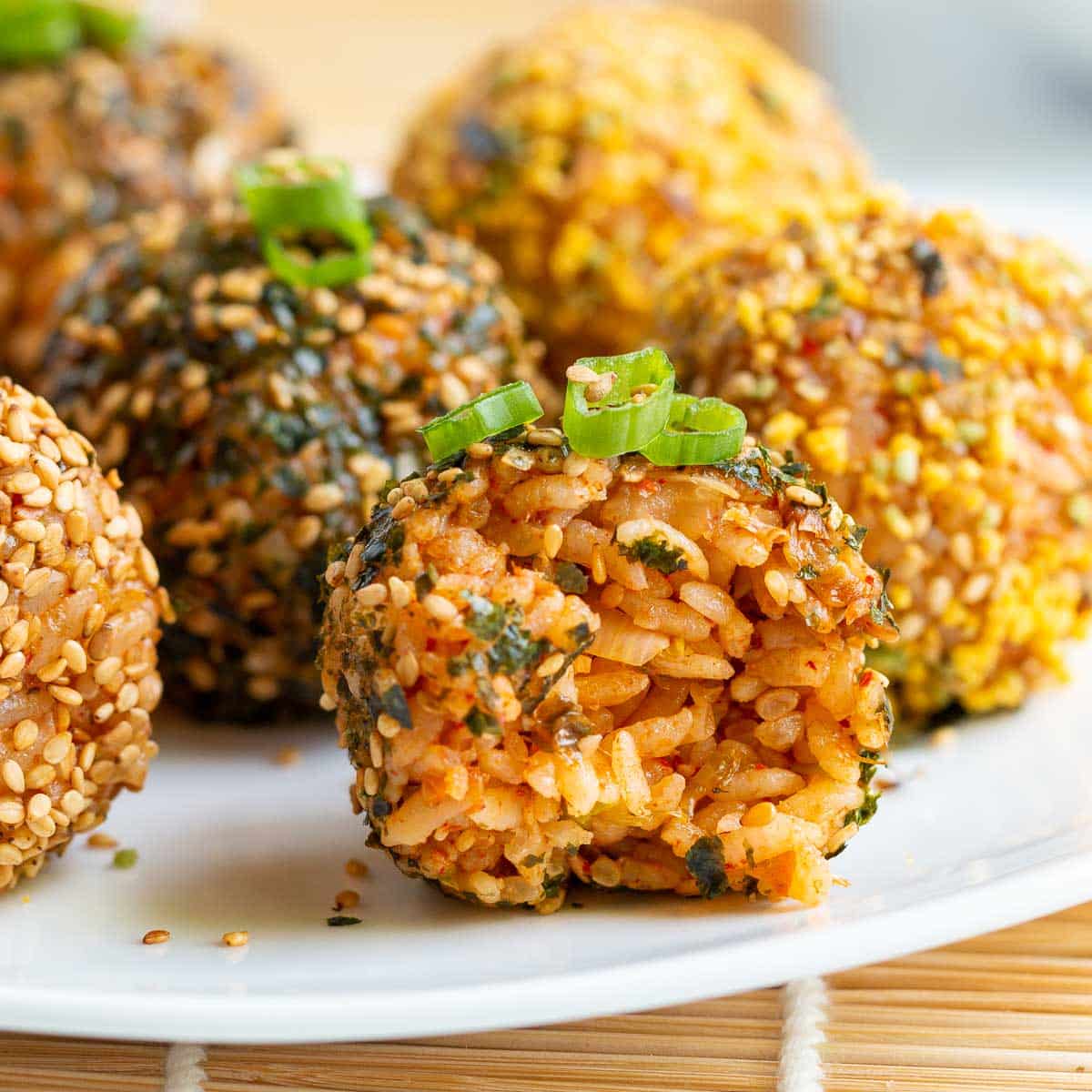
How to Serve?
This Korean kimchi and rice recipe can be served as a snack or part of a meal.
Bento boxes are a fun way to get the kids to eat school lunches. A bento box is a food safe container with a lid. It has separate sections, so food does not touch. If you’re a parent, you know the sky is falling and the world is ending if food is touching. Right? (Smiling)
However, something magical happens when you add bite sized fun to eat foods and colors in a box. If you have ever tried to get your kids to eat their sandwich or meal, you know this struggle is real. However, once we add fresh bite sized vegetables, fruits, maybe some tomagoyaki and a few rice balls - the box comes back empty every time.
Alternatively, serve kimchi rice balls as a part of a main meal with salmon cakes, salad, daikon pickles, miso soup or even beef rollups.
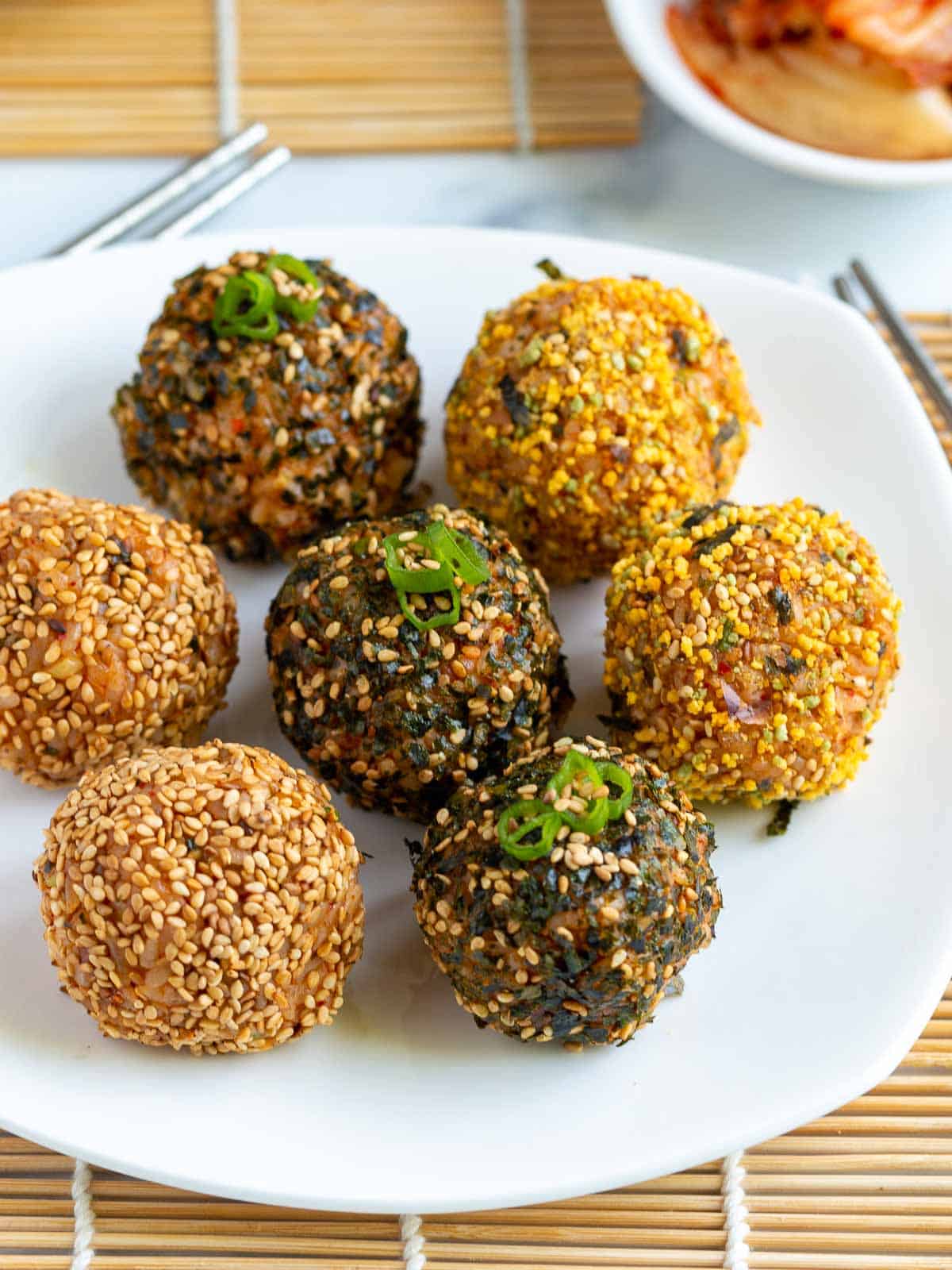
Frequent Asked Questions (FAQ’s)
You can make plain rice balls 2 to 3 days in advance and store them in a sealed container in the refrigerator. To prevent the rice balls from drying out, wrap each individually in plastic wrap before placing in the sealed container. We do not suggest freezing rice balls as it changes its texture.
Traditional kimchi is usually not vegan or vegetarian because it is made with fish sauce. You will need to double check the ingredient list before purchasing to confirm.
Japanese rice balls are usually flavored with only salt. However, Korean rice balls are seasoned with both salt AND toasted sesame oil.
Roasting seaweed lightly over the burner makes the nori seaweed sheets crispy so they crumble into small flakes that can be sprinkled on rice. In addition, it adds a delicious toasty flavor.
More Easy Bento Box Ideas
Did You Like Our Recipe? Leave a ⭐⭐⭐⭐⭐ rating and/or a review in the comments section below. Your feedback is always appreciated! Follow us for more delicious recipes on Pinterest, Instagram, Twitter and Facebook! Don't forget to sign up for our email list for more free recipes.
More Delicious Korean Recipes

Kimchi Korean Rice Balls
Equipment
- food processor or high speed blender optional - to make homemade Furikake rice seasoning
- tongs or chop sticks optional - to carefully toast the nori seaweed sheets
- pan
Ingredients
Homemade Furikake Rice Seasoning (optional) - Skip if using store bought
- 3 sheets laver (dried seaweed) nori sheets roasted (plain or seasoned)
- ½ teaspoon salt or to taste
- 3 tablespoons toasted sesame seeds
- sugar optional ingredient to taste if desired (we did not add any)
Korean Rice Balls
- 1 cup kimchi
chopped and drained - 2 green onions sliced
- 2 teaspoons sesame oil plus extra on the side to prevent your hands from sticking when rolling balls
- 1 teaspoon salt or to taste
- 1 teaspoon sugar or to taste - depends on the quality of kimchi.
- 1 tablespoon gochujang Korean Red Pepper Paste - or to taste. (Optional as it is spicy)
- 3 cups rice short grained cooked sushi rice
- 2 green onions sliced thinly
- 2 tablespoon sesame seeds
toasted - extra veggies of choice (optional) You can use up to a total of 1 and ¼ of vegetables and kimchi when combined together for a total of 3 cups of cooked rice. Make sure all your veggies are grated or cut finely and stir fried to remove any extra moisture.
- proteins or stuffing's of choice (optional) use up those cooked leftover beef bulgogi, bibimpbap beef, salmon or protein of choice chopped finely.
- Homemade Furikake Rice Seasoning or store bought (Recipe below)
Instructions
Homemade Furikake Seaweed Rice Seasoning (optional) - skip step if using store bought
- Turn a burner on to a low-medium heat. Hold the end of the seaweed sheet (nori or laver sheet) with a pair of tongs or chopsticks.
- Directly over the burner, briskly run the seaweed sheet back and forth. Do this fast and do not let it burn. The goal is to lightly toast the nori leaves all over on both sides to make them crispy. The color of the seaweed sheet will turn from a dark green to a bright Kelly green and have sort of a tie dyed look.
- Crumble the toasted nori seaweed sheets into the food processor or high powered blender. Add salt and sugar if desired. Pulse to chop until almost the size of a sesame seed. Then, add in toasted sesame seeds. Pulse just a few times so some of the sesame seeds are chopped and some are whole. Place half of the homemade furikake rice seasoning on a flat plate. Reserve the rest in a sealed container for another recipe.
Korean Rice Balls
- Finely chop kimchi, green onions and any extra cooked vegetables. (See recipe notes for additional vegetables and fillings)
- Add kimchi to the pan and stir fry until the moisture is released. (If you are not using a non-stick pan, add the sesame oil in first.) Then add the sesame oil, salt, sugar, optional gochujang paste, cooked short grained sushi rice and toasted sesame seeds. Stir fry until the rice is just warm and the ingredients are well incorporated. Set aside until the rice is warm but cool enough to touch.
- Lubricate your hands with sesame oil or water. Place approximately ¼ cup of WARM kimchi rice in your hand. With both hands, squeeze the ball tight a few times. Then form the rice into a round ball. (Alternatively, you can use a small sheet of plastic wrap to form a tight ball by twisting the end tight.) Repeat this process with the remainder of the rice. This recipe makes approximately 8 balls.
- Next, roll the kimchi rice balls in the homemade furikake seaweed rice seasoning.
- For best results, refrigerate Korean rice balls covered for 30 minutes. Enjoy
Video
Notes
- Use short-grained sushi rice cooked per the package directions. We used leftover cooked rice.
- Heat the rice before forming it into balls – just until warm so it is not too hot to handle.
- Dip your fingers into sesame oil or water and rub your hands together to prevent the rice from sticking to your hands.
- If you decide to add other veggies into the rice mixture, make sure that they are grated or chopped finely and cooked. In addition, the vegetables need to be cooked to remove any extra moisture. The ratio of cooked vegetables, including the kimchi to rice is 1 and ¼ cups vegetables to 3 cups cooked rice. If you add more, your kimchi rice balls may not hold together.
- Don’t make the rice balls too large! The larger the rice ball, the more difficult it is to make them stick together. This easy recipe makes approximately 8 golf ball Korean treats. Using approximately ¼ cup of the kimchi rice mixture for each ball is just about right.
- After you grab a scoop of rice, squeeze it with both of your hands tightly. Using this firm pressure will help the balls stay in shape.
- Use a piece of plastic wrap around the balls and tie it tightly.
- Lubricate your hands with sesame oil or water.
- Place about 2 tablespoons of the kimchi rice in your hand and flatten it out.
- Then, add about 1 teaspoon of your filling of choice.
- Place another 2 tablespoons of kimchi rice on top of the filling.
- Squeeze the rice and filling mixture together and form into a ball.
- Roll into the Korean Furikake rice seasoning.



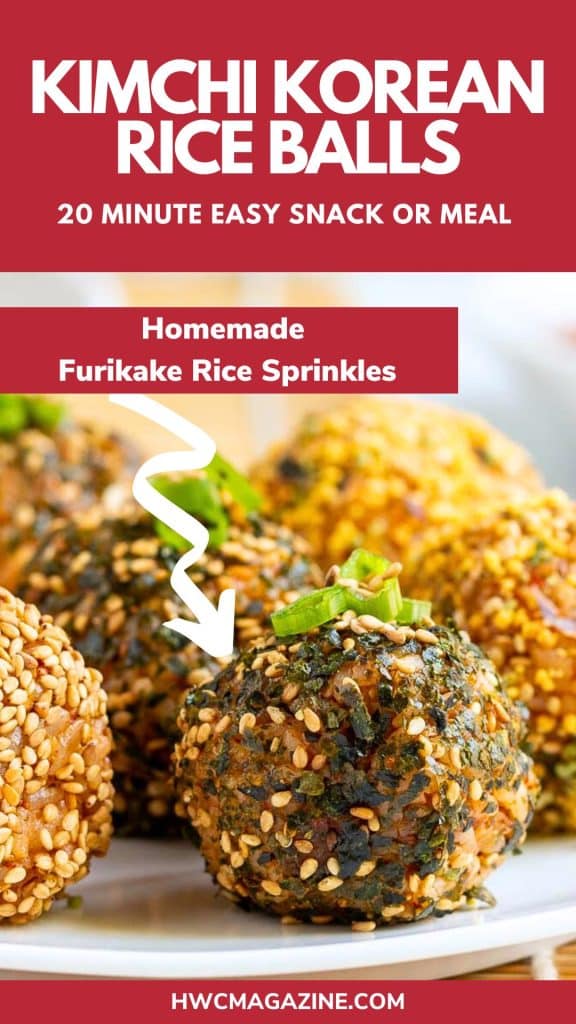
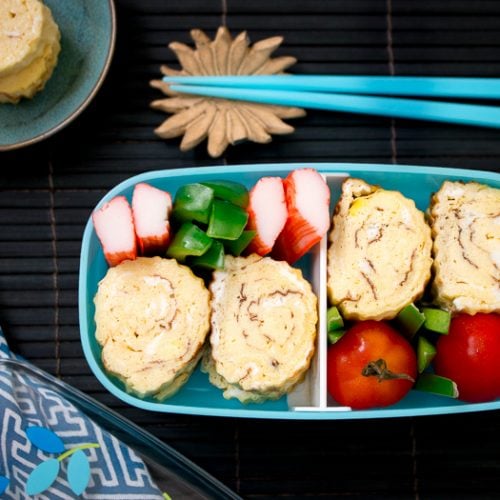
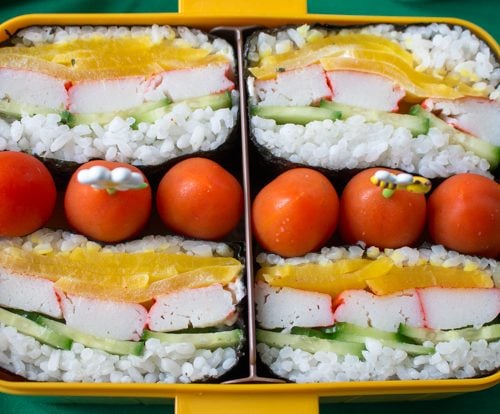
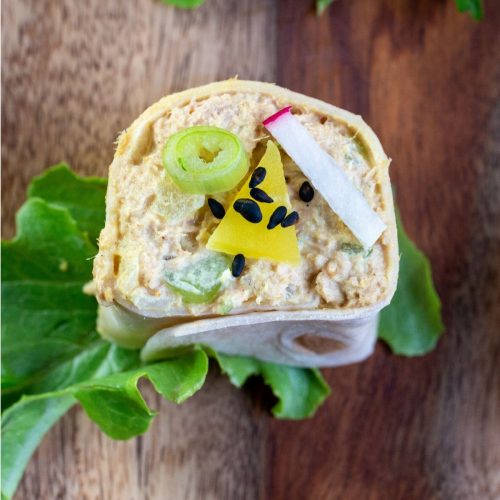
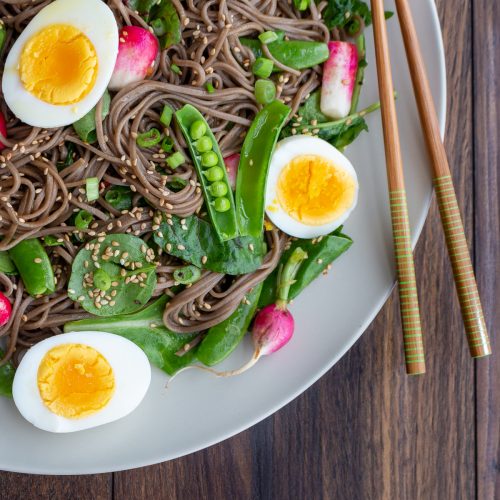
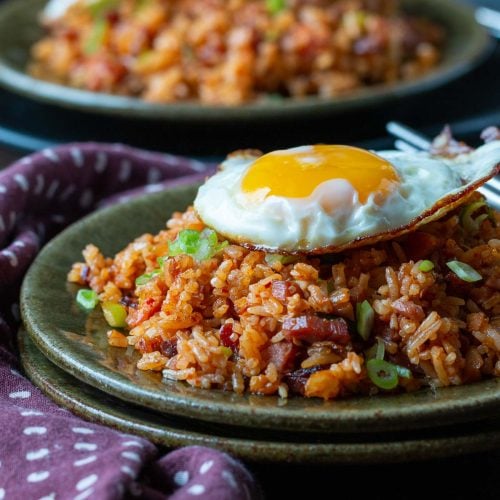
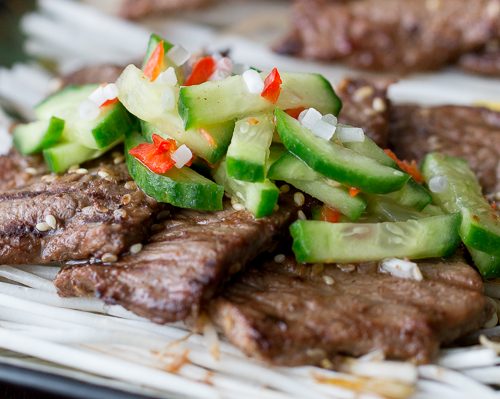

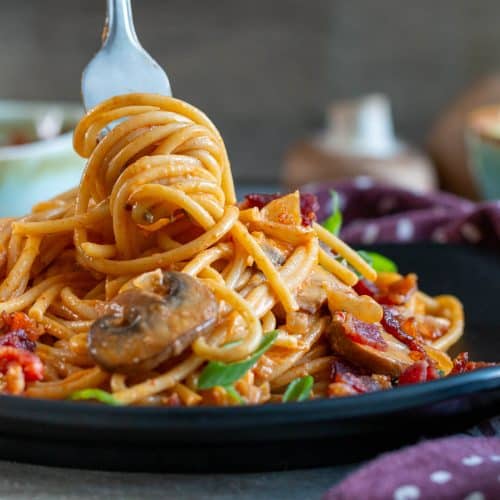
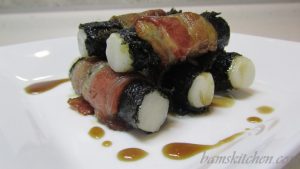
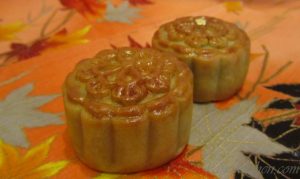

Raymund | angsarap.net says
They look absolutely delicious and perfect for satisfying cravings. The combination of leftover sushi rice with kimchi and vegetables sounds like a flavor explosion. I'm definitely going to try stuffing them with some leftover bibimbap or BBQ beef for an extra tasty twist.
HWC Magazine says
Thank you Raymund. Korean rice balls are extra delicious with a little leftover BBQ beef stuffed in the middle. Take Car
Valentina says
I can't wait to try these! So much delicious flavor in one bite! And flavors I love, to boot! Looking forward to making them. 🙂 ~Valentina
HWC Magazine says
Thank you Valentina. Korean rice balls are a great way to use up all those little bits and bobs of leftovers in the refrigerator. Take Care and enjoy your weekend.
Eha says
Wow! Am glad I picked this recipe up! I love Korean food and kimchi is usually around as is the rice . . . well, it may take a few tries to get a plateful as inviting as yours but I am game to try soonest 🙂 ! I snack on seaweed sheets so those are always around . . .
HWC Magazine says
Thank you Eha! We love Korean rice balls too. So easy to make and so is the furikake seasoning. Boys love it work lunches. Hope you are doing well. Take Care
Heidi | The Frugal Girls says
YUM... the kimchi really brings so much flavor to these rice balls. Also, that was a great tip for using tongs to hold the seaweed sheets over the burner!
HWC Magazine says
Thank you Heidi. Kimchi is one of those flavor bombs with every note of spicy, sweet, sour, savory hit. We always have a jar on hand.
Liz says
Oooh, these sound amazing! Every bite is packed full of deliciousness!!!
HWC Magazine says
Thank you Liz. Don't you just love when you can make leftovers into something that wakes up the taste buds. Hope your weekend is fabulous.
Balvinder says
I’m excited to try this recipe but I don't have kimchi. I tried making it once and it went bad after third day. Do you have a post or video for making kimchi?
The furikakae seasoning sprinkled on top of the balls is a great touch.
HWC Magazine says
I am sorry but we do not have a recipe for homemade kimchi on our website as of yet but we will add it to the recipe requests. We will make sure it is gluten free for you. Stay well and take care
Balvinder says
Yes please make and post.
Today I was looking for options to make Japanese Onigiri and Google brought to your website 🙂
HWC Magazine says
That's awesome Balvinder! We have many bento box recipes on our website. You may also like our Japanese Onigiri, tomagoyaki rolls or onigirazu
Hannah says
Oh YUM! This is like bold, spicy onigiri. I'm all about it!
HWC Magazine says
Thank you dear. It certainly has a kick to it!
EAT CHIMAC says
Oh, I just love Korean food but didn't try it.
Now I can make it at home.
It looks delicious.
Coffee and Crumpets says
As luck would have it, have some leftover ground beef in the fridge that I wanted to use up today! I've always wanted to make this but because of the time consumption, always put it off for another day. Today I need ideas for dinner and I think I just got it! Thanks Bam!
lapetitecasserole says
It represents a great way to eat... I could go crazy with a plate like that one, full of different ingredients!
Bold Wandering says
Looks delicious. I love ordering bibimbap at the Korean place around the corner, but now I can make it at home.
Asmita says
Looks so yummy, would love that for lunch or dinner.
Nami | Just One Cookbook says
Oh yes, I love Bibimbap!!!! This is a must order for me when I go to Korean restaurant. I have made this several times ago but it's my own creation that I really need to learn traditional version. Love this so much I can eat once a week...seriously! Yours looking SUPER delish!
Healthy World Cuisine says
I especially love those little fried bits of rice at the bottom of the pan. Arigato gozarimashita Nami-san!
gardenfreshtomatoes says
That reminds me of school potlucks when I was a kid... I grew up next to a large Army post, mostly Artillery...the guys cycled through Germany, Korea, and Ft. Sill. Many of my classmates mothers were German or Korean, and they would bring the most WONDERFUL foods!
By the way, I nominated you for one of those award-thingies yesterday...play along, if you want! 😀
Healthy World Cuisine says
Hello Marie, thanks for thinking of me on your post and for letting me know, as for some reason I did not get a pingback notification. Greatly appreciated. BAM